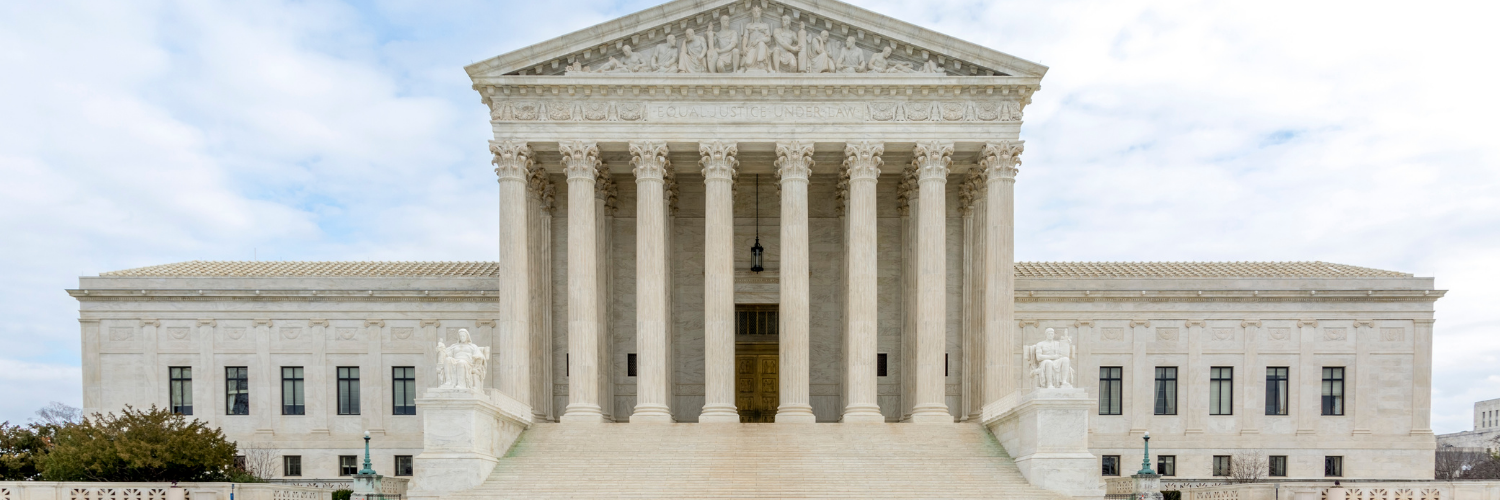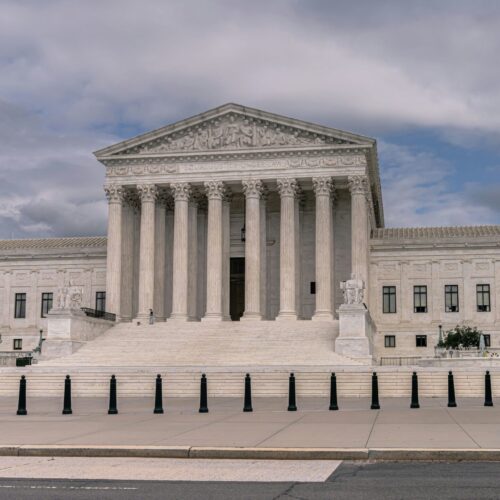Supreme Court hands down flurry of major decisions
By: Lisa Soronen, State and Local Legal Center, Washington, D.C.
The State and Local Legal Center (SLLC) files Supreme Court amicus curiae briefs on behalf of the Big Seven national organizations representing state and local governments. CSG East occasionally republishes briefs, like the one below, on cases and decisions that affect the Eastern Region.
Recent decisions handed down by the Supreme Court will have major implications for states, including a school funding case originating in Maine and a gun licensing case originating in New York. Dobbs v. Jackson Women’s Health Organization, overturning Roe v. Wade, is covered below as well.

In Carson v. Makin the U.S. Supreme Court held 6-3 that Maine’s refusal to provide tuition assistance payments to “sectarian” schools violates the First Amendment’s Free Exercise Clause.
Maine’s constitution and statutes require that students receive a free public education. Fewer than half of Maine’s school administrative units (SAUs) operate their own public secondary schools. If those SAUs don’t contract with a particular public or private school, they must “pay the tuition . . . at the public school or the approved private school of the parent’s choice.” To be approved a private school must be “nonsectarian.”
Two sets of Maine parents argued that the religious schools where they send or want to send their children can’t be disqualified from receiving state tuition payments because they are religious.
In an opinion written by Chief Justice Roberts the U.S. Supreme Court agreed. The Court began its analysis by noting that “we have repeatedly held that a State violates the Free Exercise Clause when it excludes religious observers from otherwise available public benefits.” The Court then concluded that the “unremarkable” principles applied in two recent U.S. Supreme Court cases “suffice to resolve this case.”
In Trinity Lutheran Church of Columbia v. Comer (2017) the lower court held Trinity Lutheran Church’s preschool wasn’t allowed to receive a state playground resurfacing grant because it was operated by a church. The Supreme Court reversed holding the Free Exercise Clause did not permit Missouri to “expressly discriminate against otherwise eligible recipients by disqualifying them from a public benefit solely because of their religious character.”
In Espinoza v. Montana Department of Revenue (2020) the Montana Supreme Court held that to the extent a Montana program providing tax credits to donors who sponsored private school tuition scholarships included religious schools, it violated a provision of the Montana Constitution which barred government aid to religious schools. The U.S. Supreme Court reversed stating: “A State need not subsidize private education. But once a State decides to do so, it cannot disqualify some private schools solely because they are religious.”
The U.S. Supreme Court opined that the facts of this case are very similar to those in Trinity Lutheran and Espinoza: “Just like the wide range of nonprofit organizations eligible to receive playground resurfacing grants in Trinity Lutheran, a wide range of private schools are eligible to receive Maine tuition assistance payments here. And like the daycare center in Trinity Lutheran, [the religious schools at issue in this case] are disqualified from this generally available benefit “solely because of their religious character.”
The U.S. Supreme Court concluded Maine’s exclusion of religious schools doesn’t comply with strict scrutiny because “a neutral benefit program in which public funds flow to religious organizations through the independent choices of private benefit recipients does not offend the Establishment Clause.”
Justices Breyer, Kagan, and Sotomayor dissented. Justice Breyer began his analysis writing: “The First Amendment begins by forbidding the government from ‘mak[ing] [any] law respecting an establishment of religion.’ It next forbids them to make any law ‘prohibiting the free exercise thereof.’ The Court today pays almost no attention to the words in the first Clause while giving almost exclusive attention to the words in the second.”
Justice Breyer noted that in Zelman v. Simmons-Harris (2002) the U.S. Supreme Court held “a neutral benefit program in which public funds flow to religious organizations through the independent choices of private benefit recipients does not offend the Establishment Clause.” But, “[w]e have never previously held what the Court holds today, namely, that a State must (not may) use state funds to pay for religious education as part of a tuition program designed to ensure the provision of free statewide public school education.”
In New York State Rifle & Pistol Association v. Bruen the U.S. Supreme Court held 6-3 that states and local governments may not require “proper cause” to obtain a license to carry a handgun outside the home.
In New York to have “proper cause” to receive a conceal-carry handgun permit an applicant must “demonstrate a special need for self-protection distinguishable from that of the general community.” California, the District of Columbia, Hawaii, Maryland, Massachusetts, and New Jersey have similar requirements to New York.
Justice Thomas, writing for the Court, articulated the standard the Court would apply to determine whether New York’s law violates the Second Amendment. “When the Second Amendment’s plain text covers an individual’s conduct, the Constitution presumptively protects that conduct. The government must then justify its regulation by demonstrating that it is consistent with the Nation’s historical tradition of firearm regulation. Only then may a court conclude that the individual’s conduct falls outside the Second Amendment’s ‘unqualified command.’”
Both parties agreed that the Second Amendment guarantees a general right to public carry. As Justice Thomas pointed out “[n]othing in the Second Amendment’s text draws a home/public distinction with respect to the right to keep and bear arms.”
So, the burden fell to New York to show that its proper-cause requirement is “consistent with this Nation’s historical tradition of firearm regulation.” The Court looked at gun regulation from the following time periods: (1) medieval to early modern England; (2) the American Colonies and the early Republic; (3) antebellum America; (4) Reconstruction; and (5) the late-19th and early-20th centuries. It concluded there is no historical tradition justifying a “proper cause” requirement.
“Throughout modern Anglo-American history, the right to keep and bear arms in public has traditionally been subject to well-defined restrictions governing the intent for which one could carry arms, the manner of carry, or the exceptional circumstances under which one could not carry arms. But apart from a handful of late 19th-century jurisdictions, the historical record compiled by respondents does not demonstrate a tradition of broadly prohibiting the public carry of commonly used firearms for self-defense. Nor is there any such historical tradition limiting public carry only to those law-abiding citizens who demonstrate a special need for self-defense.”
Justice Kavanaugh’s concurrence, joined by Chief Justice Roberts, notes that many of the 43 states which don’t have a “proper cause” requirement require applicants to comply with “fingerprinting, a background check, a mental health records check, and training in firearms handling and in laws regarding the use of force.” According to these Justices these “objective” licensing regimes are permissible.
The State and Local Legal Center (SLLC) filed an amicus brief in this case supporting New York. The brief highlighted the challenges police officers face in interacting with people who are armed. Justice Breyer discussed these concerns in his dissenting opinion, which Justices Sotomayor and Kagan joined. “The presence of a gun in the hands of a civilian poses a risk to both officers and civilians. Amici prosecutors and police chiefs tell us that most officers who are killed in the line of duty are killed by firearms; they explain that officers in States with high rates of gun ownership are three times as likely to be killed in the line of duty as officers in States with low rates of gun ownership.”
Larry Rosenthal, Chapman University School of Law wrote the SLLC’s amicus brief which the following organizations joined: National League of Cities, U.S. Conference of Mayors, International City/County Management Association, Major Cities Chief Association, National Police Foundation, and National Association of Black Law Enforcement Executives.
In a 6-3 decision in Dobbs v. Jackson Women’s Health Organization the U.S Supreme Court has held there is no right to an abortion under the U.S. Constitution.
Justice Alito wrote the decision for Court which overruled Roe v. Wade (1973) and Planned Parenthood v. Casey (1992). These decisions allowed women to obtain an abortion until “viability” (about 22-23 weeks).
According to the Court: “The Constitution makes no reference to abortion, and no such right is implicitly protected by any constitutional provision, including the one on which the defenders of Roe and Casey now chiefly rely—the Due Process Clause of the Fourteenth Amendment. That provision has been held to guarantee some rights that are not mentioned in the Constitution, but any such right must be ‘deeply rooted in this Nation’s history and tradition’ and ‘implicit in the concept of ordered liberty.’”
The Court opined the right to an abortion isn’t deeply rooted in our nation’s history and tradition or implicit in the right to liberty. “Until the latter part of the 20th century, such a right was entirely unknown in American law. Indeed, when the Fourteenth Amendment was adopted, three quarters of the States made abortion a crime at all stages of pregnancy. The abortion right is also critically different from any other right that this Court has held to fall within the Fourteenth Amendment’s protection of ‘liberty.’ Roe’s defenders characterize the abortion right as similar to the rights recognized in past decisions involving matters such as intimate sexual relations, contraception, and marriage, but abortion is fundamentally different, as both Roe and Casey acknowledged, because it destroys what those decisions called ‘fetal life’ and what the law now before us describes as an ‘unborn human being.’”
The Court rejected adhering to Roe and Casey because they are precedent. Justice Alito wrote: “Roe was egregiously wrong from the start. Its reasoning was exceptionally weak, and the decision has had damaging consequences. And far from bringing about a national settlement of the abortion issue, Roe and Casey have enflamed debate and deepened division.”
Chief Justice Roberts concurred in judgement only. He agreed with the Court that the “viability line established by Roe and Casey should be discarded under a straightforward stare decisis analysis. That line never made any sense.” Mississippi’s law at issue in this case prohibits abortion after the fifteenth week of pregnancy. Mississippi initially only asked the Court to reconsider the viability line, not to overturn Roe. “I would decide the question we granted review to answer—whether the previously recognized abortion right bars all abortion restrictions prior to viability, such that a ban on abortions after fifteen weeks of pregnancy is necessarily unlawful. The answer to that question is no, and there is no need to go further to decide this case.”
Justice Breyer wrote for the dissent which Justices Sotomayor and Kagan joined. They opined: “The majority has no good reason for the upheaval in law and society it sets off. Roe and Casey have been the law of the land for decades, shaping women’s expectations of their choices when an unplanned pregnancy occurs. Women have relied on the availability of abortion both in structuring their relationships and in planning their lives. The legal framework Roe and Casey developed to balance the competing interests in this sphere has proved workable in courts across the country. No recent developments, in either law or fact, have eroded or cast doubt on those precedents.”

